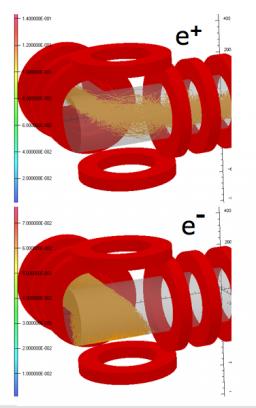
Collecting the positrons created in the tungsten target is obtained with the help of coils producing a field of around 0,2 T. the selection between e- and e+ is performed with coils arranged in the form of a magnetic dipole.
The project to measure the gravitational acceleration of antihydrogen atoms requires the production of a dense target of positronium atoms, the e+e- bound state with a lifetime in the triplet state of 142 ns. A large amount of "slow" positrons (energy range from eV to a few keV) is necessary. Radioactive sources based on 22Na are not intense enough. Moreover, the efficiency of the moderation process, which allows to slow down the positrons, must be taken into account . It varies from 10-5 to 10-2 according to the moderator type which can be used in the experimental environment. The possibility to produce positrons of low energy with an accelerator has thus been studied [2]. The process employed is pair creation from an electron beam hitting a target of high Z. For such an experiment, a dedicated beam is necessary. The price of accelerators led us to study the performances of an accelerator of very low energy (< 10 MeV) compensating the low cross section by increasing the intensity of electrons, this being limited by how the target sustains heating for an intensity of order 1 mA. This study resulted in a patent [3].
The ANR funded project SOPHI consists in a selector between electrons from the primary beam and the positrons emitted by a tungsten target at low incidence angle [2]. This selection opens the possibility to use a moderator with solid Neon to slow down efficiently the positrons from MeV to eV energies, rather than a tungsten moderator roughly 100 times less efficient. Indeed, the temperature of solid Neon at 7K does not allow to place this type of moderator in the direct environment of the electron beam which has a power of order kW.
The set comprising the target, the vacuum vessel, the coils, as well as the positron detector, was built in IRFU and by the company SigmaPhi. Delivery was performed during spring 2008



